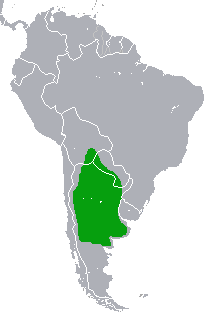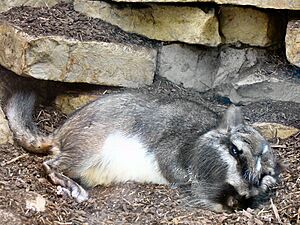Plains viscacha facts for kids
Quick facts for kids Plains viscacha |
|
|---|---|
 |
|
| Conservation status | |
| Scientific classification | |
| Genus: |
Lagostomus
|
| Species: |
maximus
|
 |
|
| Plains viscacha distriburion | |
The plains viscacha (Lagostomus maximus) is a large rodent that lives in parts of South America. It's a type of viscacha, which belongs to the same family as chinchillas. This animal is the only living species in its group, called Lagostomus. You can find plains viscachas in Argentina, Bolivia, and Paraguay. They are the biggest animals in their family. Plains viscachas build amazing underground homes called burrows. Many generations of viscachas can live in these burrows for decades.
It's important not to confuse the plains viscacha with the plains viscacha rat. They are different animals!
Contents
What Does a Plains Viscacha Look Like?
The plains viscacha is a very large rodent. It can weigh up to 9 kilograms (about 20 pounds). Its body and head can be over 50 centimeters (20 inches) long. Its tail is usually a bit shorter than 20 centimeters (8 inches).
Their fur color changes to match the soil. It can be gray or brown on their back. Their belly is usually whitish. They have a big head with a black and white face. Male viscachas have cool black mustaches and stiff whiskers. Their front feet have four toes, and their back feet have three toes.
Their fur is soft and thick. It covers them from their ears to their long, curly tail. Their front legs are short. But their back legs are long and strong. This helps them run and jump easily. The color of their fur can also change with the seasons and as they get older.
How Plains Viscachas Live and Behave
Plains viscachas live in groups in large underground homes. These homes are called burrow systems. A group usually has one or more males, several females, and young viscachas.
Viscachas come out at night to find food. During the day, they gather underground in their burrows. All members of a group use the burrows together. They also help dig and expand the burrows. Adult males often make loud alarm calls to warn the group of danger.
Female viscachas form the main social group that stays together for a long time. Male viscachas often leave their group each year. New males then join groups of females. Viscacha colonies can be small, with just a few animals, or very large, with hundreds! They have many different sounds to talk to each other. This helps them keep up with all the colony chatter. No single female is in charge of the others.
All members of a group share the same area for finding food. They eat many types of grasses and plants. Sometimes, they also nibble on small bushes.
These animals like to collect branches and heavy things. They use these items to cover the entrance to their burrows. If they live near people, they might even collect brooms, tables, garden tools, or pieces of concrete! They use these human-made objects to cover their homes too.
Types of Plains Viscachas
There are a few different types, or subspecies, of plains viscachas:
- L. m. inmollis
- L. m. maximus
- L. m. peltilidens
Protecting Plains Viscachas
Right now, there are no special plans just for protecting the plains viscacha. However, they do live in several protected areas. This helps keep them safe. People don't think hunting is a big problem for them yet. But it's important to keep an eye on their numbers. This way, we can make sure hunting doesn't start to harm their population.
See also
 In Spanish: Vizcacha de las llanuras para niños
In Spanish: Vizcacha de las llanuras para niños



